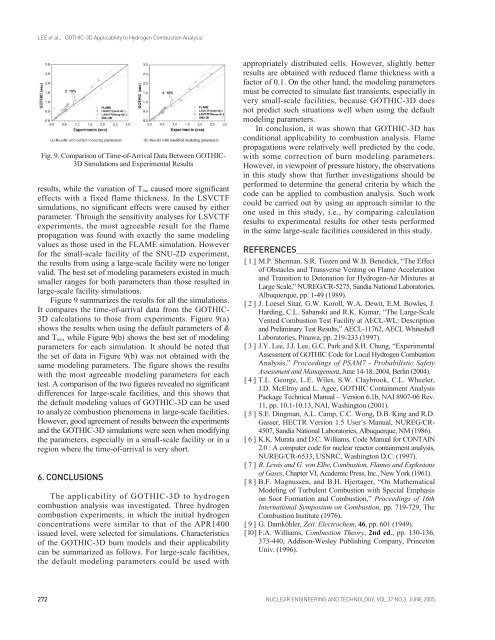GOTHIC-3D APPLICABILITY TO HYDROGEN COMBUSTION ANALYSIS
Create successful ePaper yourself
Turn your PDF publications into a flip-book with our unique Google optimized e-Paper software.
LEE et al., <strong>GOTHIC</strong>-<strong>3D</strong> Applicability to Hydrogen Combustion Analysis<br />
Fig. 9. Comparison of Time-of-Arrival Data Between <strong>GOTHIC</strong>-<br />
<strong>3D</strong> Simulations and Experimental Results<br />
results, while the variation of T lim caused more significant<br />
effects with a fixed flame thickness. In the LSVCTF<br />
simulations, no significant effects were caused by either<br />
parameter. Through the sensitivity analyses for LSVCTF<br />
experiments, the most agreeable result for the flame<br />
propagation was found with exactly the same modeling<br />
values as those used in the FLAME simulation. However<br />
for the small-scale facility of the SNU-2D experiment,<br />
the results from using a large-scale facility were no longer<br />
valid. The best set of modeling parameters existed in much<br />
smaller ranges for both parameters than those resulted in<br />
large-scale facility simulations.<br />
Figure 9 summarizes the results for all the simulations.<br />
It compares the time-of-arrival data from the <strong>GOTHIC</strong>-<br />
<strong>3D</strong> calculations to those from experiments. Figure 9(a)<br />
shows the results when using the default parameters of f<br />
and T lim, while Figure 9(b) shows the best set of modeling<br />
parameters for each simulation. It should be noted that<br />
the set of data in Figure 9(b) was not obtained with the<br />
same modeling parameters. The figure shows the results<br />
with the most agreeable modeling parameters for each<br />
test. A comparison of the two figures revealed no significant<br />
differences for large-scale facilities, and this shows that<br />
the default modeling values of <strong>GOTHIC</strong>-<strong>3D</strong> can be used<br />
to analyze combustion phenomena in large-scale facilities.<br />
However, good agreement of results between the experiments<br />
and the <strong>GOTHIC</strong>-<strong>3D</strong> simulations were seen when modifying<br />
the parameters, especially in a small-scale facility or in a<br />
region where the time-of-arrival is very short.<br />
6. CONCLUSIONS<br />
The applicability of <strong>GOTHIC</strong>-<strong>3D</strong> to hydrogen<br />
combustion analysis was investigated. Three hydrogen<br />
combustion experiments, in which the initial hydrogen<br />
concentrations were similar to that of the APR1400<br />
issued level, were selected for simulations. Characteristics<br />
of the <strong>GOTHIC</strong>-<strong>3D</strong> burn models and their applicability<br />
can be summarized as follows. For large-scale facilities,<br />
the default modeling parameters could be used with<br />
appropriately distributed cells. However, slightly better<br />
results are obtained with reduced flame thickness with a<br />
factor of 0.1. On the other hand, the modeling parameters<br />
must be corrected to simulate fast transients, especially in<br />
very small-scale facilities, because <strong>GOTHIC</strong>-<strong>3D</strong> does<br />
not predict such situations well when using the default<br />
modeling parameters.<br />
In conclusion, it was shown that <strong>GOTHIC</strong>-<strong>3D</strong> has<br />
conditional applicability to combustion analysis. Flame<br />
propagations were relatively well predicted by the code,<br />
with some correction of burn modeling parameters.<br />
However, in viewpoint of pressure history, the observations<br />
in this study show that further investigations should be<br />
performed to determine the general criteria by which the<br />
code can be applied to combustion analysis. Such work<br />
could be carried out by using an approach similar to the<br />
one used in this study, i.e., by comparing calculation<br />
results to experimental results for other tests performed<br />
in the same large-scale facilities considered in this study.<br />
REFERENCES_______________________________<br />
[ 1 ] M.P. Sherman, S.R. Tiezen and W.B. Benedick, “The Effect<br />
of Obstacles and Transverse Venting on Flame Acceleration<br />
and Transition to Detonation for Hydrogen-Air Mixtures at<br />
Large Scale,” NUREG/CR-5275, Sandia National Laboratories,<br />
Albuquerque, pp. 1-49 (1989).<br />
[ 2 ] J. Loesel Sitar, G.W. Koroll, W.A. Dewit, E.M. Bowles, J.<br />
Harding, C.L. Sabanski and R.K. Kumar, “The Large-Scale<br />
Vented Combustion Test Facility at AECL-WL: Description<br />
and Preliminary Test Results,” AECL-11762, AECL Whiteshell<br />
Laboratories, Pinawa, pp. 219-233 (1997).<br />
[ 3 ] J.Y. Lee, J.J. Lee, G.C. Park and S.H. Chung, “Experimental<br />
Assessment of <strong>GOTHIC</strong> Code for Local Hydrogen Combustion<br />
Analysis,” Proceedings of PSAM7 - Probabilistic Safety<br />
Assessment and Management, June 14-18, 2004, Berlin (2004).<br />
[ 4 ] T.L. George, L.E. Wiles, S.W. Claybrook, C.L. Wheeler,<br />
J.D. McElroy and L. Agee, <strong>GOTHIC</strong> Containment Analysis<br />
Package Technical Manual – Version 6.1b, NAI 8907-06 Rev.<br />
11, pp. 10.1-10.13, NAI, Washington (2001).<br />
[ 5 ] S.E. Dingman, A.L. Camp, C.C. Wong, D.B. King and R.D.<br />
Gasser, HECTR Version 1.5 User’s Manual, NUREG/CR-<br />
4507, Sandia National Laboratories, Albuquerque, NM (1986).<br />
[ 6 ] K.K. Murata and D.C. Williams, Code Manual for CONTAIN<br />
2.0 : A computer code for nuclear reactor containment analysis,<br />
NUREG/CR-6533, USNRC, Washington D.C. (1997).<br />
[ 7 ] B. Lewis and G. von Elbe, Combustion, Flames and Explosions<br />
of Gases, Chapter VI, Academic Press, Inc., New York (1961).<br />
[ 8 ] B.F. Magnussen, and B.H. Hjertager, “On Mathematical<br />
Modeling of Turbulent Combustion with Special Emphasis<br />
on Soot Formation and Combustion,” Proceedings of 16th<br />
International Symposium on Combustion, pp. 719-729, The<br />
Combustion Institute (1976).<br />
[ 9 ] G. Damköhler, Zeit. Electrochem, 46, pp. 601 (1949).<br />
[ 10 ] F.A. Williams, Combustion Theory, 2nd ed., pp. 130-136,<br />
373-440, Addison-Wesley Publishing Company, Princeton<br />
Univ. (1996).<br />
272 NUCLEAR ENGINEERING AND TECHNOLOGY, VOL.37 NO.3, JUNE 2005



